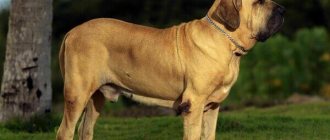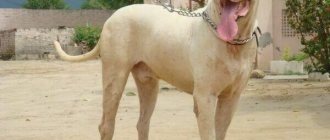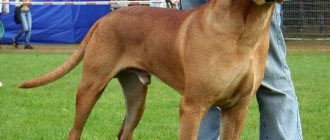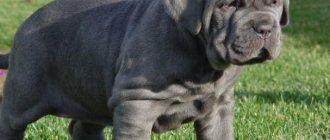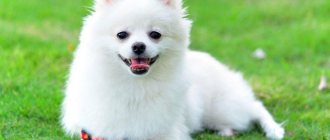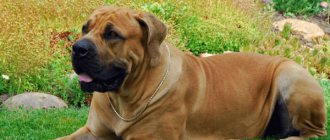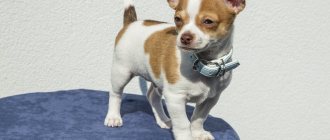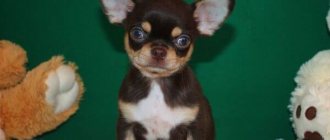Mastiffs are a group of breeds that share certain characteristics. In particular, very large sizes.
These include Tibetan, English, French, American, Spanish, Major, Japanese and other varieties of mastiffs.
Pyrenean Mastiffs are noble and majestic dogs.
They are capable of instilling fear in people unfamiliar with this breed by their appearance alone.
But once you get to know them better, it becomes clear that under the mask of a formidable dog hides a good-natured, affectionate and loyal friend and companion.
Origin story and what it looks like in the photo
Pyrenean Mastiffs are one of the oldest dogs, descended from Molossians who lived in Phenicia 3-4 thousand years ago..
Spain is considered the birthplace of the breed, since it was formed in the Pyrenees, on the territory of the then existing kingdom of Aragon.
These dogs were not used for hunting . Their breeding had the sole purpose of obtaining strong and hardy animals capable of withstanding long journeys of flocks and protecting sheep from wolves and people from bears.
Despite their ferocious appearance and unfriendly attitude towards strangers, due to living in a sparsely populated area, the dogs obeyed the shepherds.
When breeding this breed, the exterior was not taken into account; the main thing was the large size of the animals . Different regions of residence led to the formation of several types of dogs that were not crossed with each other.
This is how 2 different breeds with a common ancestor appeared - Spanish and Pyrenean mastiffs.
At the end of the 19th century. A canine exhibition was held in Madrid, where the Pyreneans also participated. After her, this breed quickly gained enormous popularity, but it did not last long, because
The Second World War, after which Spain found itself in a political and economic crisis and there was no longer a need for large dogs. So the Pyrenean mastiffs were on the verge of extinction.
This breed managed to attract the attention of dog breeders again in the 70s. XX century
In 1977, the Pyrenean Mastiff Club was organized in Spain, uniting breeders, in 1981 the breed standard was approved, and in 1982 it was recognized by the International Canine Association.
Buy | sell
| 30000 MoscowNovember 12, 2015 Pyrenean mastiff puppies were born in the Valenz House kennel on January 3, 2015 - 3 girls, 3 boys. Vaccinated according to age. Branding. Full package… |
| 50000 Moscow6 February 2015 Pyrenean Mastiff puppies for sale. Born on November 28, 2014. Vaccinated according to age. Branding. Full package of documents. Exhibition exterior. For… |
| 50000 January 10, 2015 High-pedigree show and breed class puppies from a very beautiful couple with a wonderful temperament. Five boys and five girls, white-gray and white-black... |
rare breed puppies.55000 July 18, 2010 A litter of a rare breed of Pyrenean Mastiff appeared in the “STAR SHAINE” kennel. Puppies were born on April 3, 2010. The dogs are very large, not for city life. ... |
Description and standard
Pyrenean Mastiffs are large, harmoniously built dogs with moderate body proportions and powerful, strong bones. At the same time, they do not look overweight, heavy and slow; rather, they convey restrained strength and energy.
Breed standard:
- the skull is wide and slightly rounded;
- the head is large and strong, the muzzle is square;
- the neck is flexible, with developed muscles;
- rectangular body, strong but flexible;
- the back is straight, muscular;
- the loin is long and wide;
- the eyes are small, almond-shaped, set straight, brown in color, eyelids dark;
- ears are triangular, hanging;
- the croup is wide and strong;
- the tail is thick at the base, set high;
- limbs are straight, set parallel, muscles and tendons are clearly visible;
- paws are round in shape, dense pads;
- scissor bite.
The coat is double, the outer hairs are dense, hard, thick, moderately long - in the center of the body they reach 6-9 cm.
The hair is longer on the neck, shoulders, belly, back of the limbs and tail.
Types of Mastiffs
The Mastiff family includes several varieties of dogs. Each of them has distinctive characteristics, despite the fact that they are the same breed. What types of mastiffs there are are described below.
Tibetan
This shaggy mastiff has a beautiful appearance. The dogs have long, thick hair and a powerful build. The head is proportional to the body, the nose is large, the eyes are almond-shaped.
The Tibetan Mountain Mastiff is a very good guard, has high intelligence, and can be stubborn, so training should begin at a young age.
Neapolitan (Neapolitan)
It is also called Italian and originates from Roman mastiffs.
A dog with blue, black or gray short hair and folds on the face. The body is slender, the limbs are straight, well developed, the tail resembles a saber.
For reference! Neapolitan dogs are friendly, great with children, black mastiff and gray (blue) mastiff are excellent guard dogs.
English (Scottish Mastiff)
This breed is considered a classic species, characterized by a large build and short hair. The muzzle is wide, the nose is large and black. Dogs are strong, independent, but at the same time they really need affection and care.
They are attached to their owner, treat children well, sometimes they show laziness, although in general the dogs are very active.
Spanish
Representatives of this species are distinguished by their coarse fur of a variety of colors. They have a thick skin that hangs in large folds on the neck, chest and abdomen.
Pets are very loyal and caring, but in some cases they can be stubborn, so raising puppies needs to be done from an early age.
Bullmastiff
This breed was developed by crossing bulldogs and mastiffs. Therefore, the dog turned out to be large, with a rather menacing appearance.
Smooth-haired European Mastiff, colors may vary. This is a wonderful breed that is loyal, not stubborn and trains well.
It is also worth noting that the dog is not as phlegmatic as other varieties.
Iberian
White mastiff with medium length coat. The color is light with dark marbled spots, and there is a rather pronounced mask on the face. The muzzle is large and wide. Dogs with good intelligence, very friendly and affectionate, are good with children.
Neapolitan impresses with its beautiful appearance
French (Bordeaux)
A strong and agile red mastiff, looks a little like a bulldog. The coat is short and there is a white spot on the chest. It is necessary to educate and socialize from an early age, although it has a calm character.
Japanese (Tosa Inu)
These are Japanese fighting dogs with a large body and a straight back. The head is wide and large, there is a fold on the neck.
For reference! The brown mastiff is distinguished by fearlessness and courage, very loyal, amenable to training, although not without stubbornness.
Brazilian (Fila Brazilero)
The yellow or brindle mastiff is distinguished by dewlap in the area of the neck and abdomen. The coat is short and smooth. Sometimes it shows stubbornness, but is considered the best guard variety. Devoted to the owner and his family.
Mayorsky (Ca de Bou)
Short-haired dogs with almond-shaped eyes and a narrowed muzzle. Very loyal and friendly.
All mastiff breeds are varied, so you can choose any variety you want.
Pyrenean dogs are not very similar to dogs from the mastiff family
Pet character
While giving the impression of being a formidable and even dangerous dog, Pyrenean Mastiffs actually have a calm and good-natured character.
Thanks to painstaking work, breeders managed to consolidate in these dogs the main positive quality - balance.
Representatives of this breed behave meekly and affectionately with members of their family. They treat everyone with the same respect and obedience, but they see only one person as the owner.
They are not prone to causeless aggression and to protect the house, all they need is their own formidable appearance, however, if the dog or his family is in danger, he will not hesitate to defend himself.
Pyrenean Mastiffs seem phlegmatic and clumsy, but this is not the case.
Representatives of this breed are quite playful and dexterous, they love walks, games and spending time with their owners . At the same time, they are not imposed and do not require undivided attention.
These dogs are independent and are used to making their own decisions, especially when it comes to guarding.
Thanks to their intelligence and intelligence, they are easy to train; difficulties can arise only in making the dog see himself as a leader and leader.
It is necessary to start education from early childhood; it is important to develop a regime and rules of behavior and not violate them.
Thanks to their friendliness and calmness, Pyrenean Mastiffs easily find a common language with other animals. They love children, tolerate their pranks and play with pleasure.
The mastiff perceives everyone who lives in the same territory as a herd, which he considers it his duty to protect and protect..
Expert opinion
Kozhevin Semyon Kirillovich
Expert dog handler.
Of course, these are kind and friendly dogs, but only if they are properly raised. Representatives of this breed need the earliest possible socialization - this is the only way they can learn to identify strangers and not be overly wary of loved ones and family friends. Pyrenean Mastiffs are smart and quickly learn commands, but they are very independent and will not listen to everyone - they need an experienced owner, a leader with a strong character.
Top 10 largest dogs in the world
When thinking about buying a large dog, many people carefully study the breed market, choosing the ideal option for their family.
If one of the main criteria for your choice is the size of the dog, then you should pay attention to the rating of the largest breeds
So, the top largest dog breeds in the world!
english mastiff
- English Mastiff. Due to their docile and friendly nature, representatives of this breed are often called gentle giants. This is an ancient breed of dog that lived in Ancient Babylon and was used to hunt lions. The height at the withers varies in the range of 70-91 cm, regardless of the gender of the dog. Average weight starts from 55 kg and can reach 100 kg!
- Spanish Mastiff. This breed is slightly inferior to the previous one, because the average height of such dogs is from 72 to 88 cm, and their weight ranges from 70 to 120 kg!
- Saint Bernard One of the most familiar breeds for the Russian average person. This is not only a large, but also a heavy dog, because the weight of representatives of this breed is not inferior to mastiffs and can reach 100 kg. The average height of a St. Bernard at the withers is 65-90 cm.
- Pyrenean Mastiff. The Hygina breed has been used for a long time as a herder for animals. The height of representatives of this breed is never lower than 72 cm, and for males it reaches 81 cm. Weight most often is 70-80 kg, although some mastiffs can be heavier.
- German dog. An incredibly elegant and graceful dog, the height of which in the hall is rarely lower than 8 cm, and in females - 72 cm. It is this breed that is included in the Guinness Book of Records as the tallest. With impressive growth, Great Danes have a low weight: from 45 to 90 kg.
- Tibetan mastiff. These furry inhabitants of the Himalayas also delight in their size. The height is up to 81 cm, and the weight is from 40 to 80 kg. The weight of the largest Tibetan mastiff is 112 kg.
- Newfoundler or diver. This breed is considered a faithful assistant to fishermen. She has a water-repellent coat and paws that are ideal for swimming. Due to their powerful strength, these dogs are considered excellent rescuers. The average height of a dog is from 65 to 75 cm. The representative of this breed, the female Barbara Alens Dark Hans, is considered the strongest dog, because with her own weight of 44 kg, she was able to stretch a load of almost 2300 kg.
- Boerboel. A service dog, an excellent guard dog, can reach a height of up to 70 cm and weigh 70-90 kg. This is a powerful human assistant.
- Moscow watchdog. The breed was developed in Russia. The minimum height of these dogs is 66-68 cm. Males weigh from 60 kg and above, and females look more graceful and their average weight starts from 45 kg.
- Leonberger. A large breed that was bred in Germany in the century before last. Height can reach up to 80 cm, and weight can reach 77 kg.
Moscow watchdog
The list of the largest dogs in the world would be incomplete without mentioning other large breeds, including Alabai, Neapolitan Mastiffs, Irish Wolfhounds, Hungarian Kuvasz, Caucasian Shepherd Dogs, Buryat-Mongolian Wolfhounds, Pyrenean Mountain Dogs, Komondors, Anatolian Shepherds, Russian Black Terriers , Bullmastiffs, Dogo Bordeaux, Swiss Mountain Dogs, herding South Russian Shepherd Dogs, American Akitas, Dogo Argentino, Russian Greyhounds, Cane Corsos, Deerhounds, Estrela Shepherd Dogs. The average weight of these breeds does not fall below 40 kg, and the height is 60 cm.
Advantages and disadvantages
In addition to the fact that these dogs are not at all aggressive, they have some other advantages.:
- calmness and balance;
- fearlessness;
- friendly character;
- endurance;
- ability to learn;
- unobtrusive disposition;
- devotion;
- ability to get along with animals and children.
Among the disadvantages of representatives of this breed are::
- the need for early socialization and proper education;
- independence;
- not suitable for apartment living;
- low life expectancy.
For allergy sufferers, a significant drawback of these dogs is their coat, which can provoke the development of allergic reactions.
Color variations
The color of the coat of the Pyrenean Mastiffs gives them an external resemblance to St. Bernards.
The coat is always white, there is a mask of brown, black, yellow or gray on the face, and spots on the body that match the mask.
The most preferred colors include white with grey, yellow, brown, silver grey, black, light beige, merle or sand markings.
Solid white or tri-colored coats are not acceptable according to the breed standard.
The lower third of the limbs and the tip of the tail are always white.
Is it suitable for living in an apartment? On the street?
The Pyrenean Mastiff can be kept in an apartment provided that the dog is given enough space to rest comfortably, but even then this is not the best option.
Representatives of this breed are large, freedom-loving animals that require long walks that combine physical and mental stress..
NOTE!
The ideal option for keeping these dogs is a private house within the city or outside it with a large local area.
A spacious enclosure with a canopy should be equipped, since due to their thick coat, mastiffs tolerate frost well, but do not cope well with the summer heat.
You can't put these dogs on a chain - the lack of freedom provokes anger in them.
Training
You need to raise a puppy from the first days of his appearance in the house. This is a very smart dog, understands its owner. They master new skills from an early age and quickly learn commands. They want to please the owner and receive his praise. Sometimes they can be stubborn. In this case, it is necessary to slowly, gently subdue the dog.
Under no circumstances should you physically punish or humiliate your dog.
It is better if training takes place in a playful way. The main rule is regularity, without long time intervals. Otherwise, the pet will forget everything it has learned. In general, the Mastiff is easy to train, it just takes patience and time. It is necessary to constantly consolidate the acquired skills, bringing them to a reflex. During walks, you should check how well the puppy knows the learned commands. If you need a service dog, it is best to take a training course from a specialist.
The Pyrenean Mastiff has a royal stature and a stately gait. This is a fairly large dog, so before you bring it into your apartment, you need to study all the pros and cons of the breed. If you make a firm decision to buy a pet, it will become a true friend and caring nanny for your children.
How to properly care
Caring for Pyrenean Mastiffs is easy.
Caring for these, like any other dogs, is a set of hygiene procedures that the puppy must be accustomed to from early childhood, timely deworming, treatment for external parasites, and vaccination.
Wool and bathing
The coat should be brushed with a slicker brush 2-3 times a week, and during shedding - daily . After walks, you need to wash your dog’s paws, but you should give him a full bath no more than once every 3-4 months.
More frequent washing negatively affects the quality of wool.
Eyes and teeth
Representatives of this breed have strong teeth and are not prone to developing diseases associated with them. If plaque forms, you should contact a veterinarian who will remove it.
Eyes must be examined daily . If you notice increased lacrimation, you need to rinse them with chamomile infusion and consult a veterinarian if this does not help get rid of the problem.
Ears
In winter, your pet’s ears need to be cleaned twice a week, in summer – every day. Chlorhexidine can be used to remove accumulated wax.
Claws
Once every 3-4 weeks, the claws of puppies need to be trimmed; in adults, they should be ground down on their own during walks . If this does not happen, they need to be shortened using a nail clipper about once a month.
Walk
Wherever the Pyrenean Mastiff lives - in an apartment or in the courtyard of a private house - it must be walked twice a day for 1.5-2 hours.
Nutritional Features
Pyrenean Mastiffs are not picky eaters: they can be fed with natural products or industrial feed, as long as the diet is balanced and nutritious.
A natural menu should include:
- meat and offal;
- dairy products;
- cereals;
- eggs;
- vegetables, fruits and herbs;
- fish.
You can't feed Pyrenean Mastiffs:
- smoked meats, pickles, sweets, chocolate;
- canned food;
- spicy and fried foods;
- tubular bones;
- pasta;
- potatoes;
- legumes
It is also necessary to ensure that all products are fresh and of high quality and not to allow the dog to feed leftovers from the common table.
If the choice falls on industrial feed, you need to choose products of at least premium class.
Food brands Brit, Flatazor, Acana, Royal Canin received good reviews from dog breeders and breeders..
How many times a day and in what portions
The number of feedings for an adult dog depends on its level of activity: if the pet leads a sedentary lifestyle, it should be fed once a day, but if it walks and moves a lot - 2 times.
IMPORTANT!
The serving volume is calculated as follows: the dog’s weight (kg) must be multiplied by 0.7, then subtracted 15%, and the resulting number divided by the number of feedings per day.
Representatives of this breed are prone to obesity, so they should not be overfed.
Necessary care
Caring for this pet includes several points.
Feeding
To understand how a dog should eat properly, you should remember that they are all predators. Their teeth and fangs are designed to tear meat and gnaw bones, and a wide esophagus and concentrated gastric juice serve to facilitate the digestion of large pieces. When planning your diet, you need to take these features into account.
- The majority, approximately two-thirds, of the dog’s food intake should be protein foods. This includes lean meat and offal, cottage cheese, eggs and fatty fish. Raw tripe is extremely beneficial. All these products are best given raw; the meat can sometimes be boiled.
- The rest of the diet should consist of a variety of fruits and vegetables. They are also recommended to be given raw. Under the influence of coarse fiber, the correct microflora is formed in the dog’s intestines; boiled vegetables will be useless.
- Porridge has virtually no benefits for dogs. Only carbohydrates are digested from cereals, which contribute to the accumulation of fats. Therefore, if they are given to a wolfhound, then only in winter, when additional energy is required. The norm for a representative of this breed will be no more than one glass per week. Read more: Tips and recipes from experienced dog handlers: porridge for dogs
- You need to add vitamin and mineral complexes to your dog’s diet, which can be purchased at any veterinary pharmacy. Before introducing vitamins, you should read the instructions or consult a veterinarian.
- In addition, it is good to add 2 tablespoons of vegetable oil or 100 grams to your diet daily. fatty fish. This is a good source of polyunsaturated fatty acids for any organism.
- Breeders also recommend adding 2-3 tablets of brewer's yeast, a tablespoon of bran and half a teaspoon of fish oil to the diet of a puppy and an adult dog every day. And a couple of times a week you should treat your pet with beekeeping products.
- The dog should not be overfed. The puppy should look underfed rather than fat (Cerberus diet depending on age: what should you feed your puppy?). Under the influence of excess weight, the dog may develop disorders in the paw ligaments and problems with the spine. To prevent your dog from overeating, it is necessary to remove the bowl out of reach of it immediately after it has had enough. Usually 10-15 minutes are enough for this.
- The amount of food depends on the activity and place of residence of the dog. Moreover, in winter she needs almost twice as much food to maintain her energy at the proper level.
- If it is not possible to feed your pet natural products, you should choose only premium dry food. For example, .
- The bowls from which the dog eats should be no lower than chest level. To do this, it is recommended to purchase special stands in the store.
Hygienic grooming
The coat of the Great Pyrenees Mountain Dog requires the most careful care from the owner. It must be combed at least 3 times a week, otherwise tangles will form that can only be trimmed.
Despite the fact that the coat of the Pyrenean wolfhound is white, it does not get dirty very often. It is recommended to wash such dogs no more than four times a year.
IMPORTANT! Pyrenean mountain dogs cannot be groomed. After this procedure, problems with skin and parasites are possible.
Particular attention should be paid to your pet's ears. They must be cleaned with cotton pads or swabs, which are moistened in special solutions
How to choose?
Before purchasing a puppy, you need to decide on its gender, coat color and purpose of purchase..
So, for participation in breeding and for families with small children, it is better to buy a female, and for an exhibition career it is worth buying a male, despite the fact that they are more stubborn and willful.
You need to carefully examine the puppy; he should not have rashes, irritations, malocclusion, dandruff and other manifestations of disease or signs of abnormal development.
By the time of moving, the puppy must have at least 1 vaccination, a note about which, as well as about the deworming performed, is placed in the veterinary passport.
Choosing a Puppy Breed
Pyrenean Mastiff In Russia, the Pyrenean Mastiff is rare. The main livestock is concentrated in Spain and France. A significant number of dogs and kennels are located in the Baltic states. Future owners of the Pyrenean Mastiff should decide in advance on the desired gender, color and purpose of the dog. Are you planning to participate in exhibitions, breeding, or do you just need a guard and a companion? Males tend to be more dominant, females are better suited to families with children. For breeding or exhibitions, it is better to take teenagers; it is difficult to discern a champion in a 2-3 month old baby. An equally important point is the choice of the breeder. An experienced dog handler will definitely tell you which of the kids is more suitable in terms of temperament and external characteristics, and will give recommendations on raising, upbringing and other issues. It is recommended to pick up puppies no earlier than 2.5 months. Pay attention to appearance, compliance with the standard and conditions of detention. The opportunity to roam freely is welcome. Be sure to evaluate feeding. A balanced diet for mother and baby is the key to future health. Each puppy must have a brand and a puppy card, which is later exchanged for a pedigree, a veterinary passport with notes on preventive measures and vaccinations. It is also necessary to evaluate the psyche of the parents or at least the mother. Her appearance after giving birth and breastfeeding will tell about the breeder’s attitude towards his dogs.
